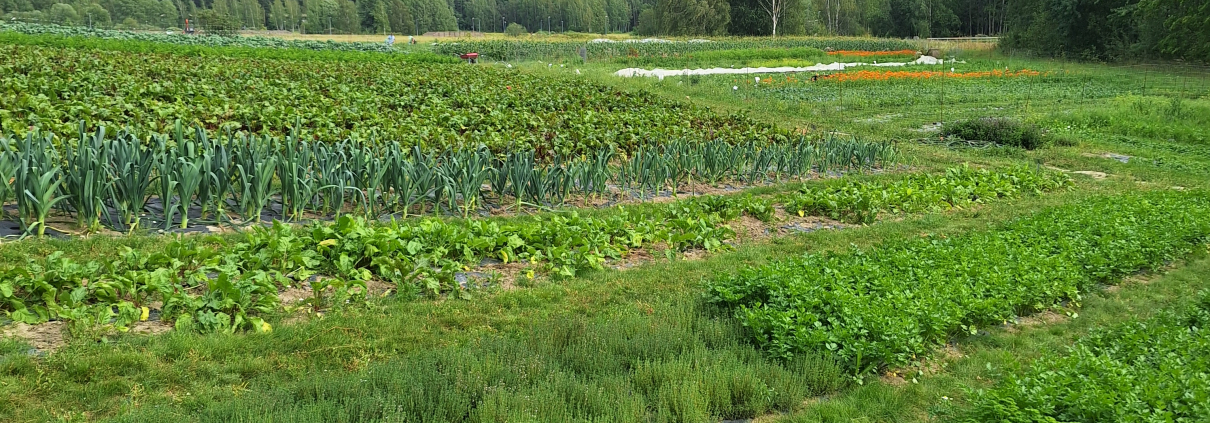Master’s Thesis: System Mapping of Key Strategies to Develop Biodiversity in Swiss Agriculture
Results from Pinja Pöytäniemi’s master’s thesis
Agriculture is essential for food security, but it is also a major cause of biodiversity loss. In Switzerland, many habitats and species are endangered and government monitoring programmes show a steady decline in ecological quality.
In this study, solutions were sought using participatory system mapping (Causal Loop Diagrams) and deep leverage points – key points where change can have the greatest impact. The study involved farmers, public authorities and biodiversity experts who identified challenges and opportunities for improving the ecological status of agricultural land.
Key findings
Barriers to promoting biodiversity
- Economic pressure: farmers focus primarily on food production due to market demands. Promoting biodiversity is often economically unviable, at least in the short term.
- Regulatory burden: Stringent environmental regulations cause frustration and reduce farmers’ willingness to support biodiversity activities and their ability to adapt them to their ecological and operational context.
- Public opinion: society blames farmers for biodiversity loss, but consumers are not willing to pay more for sustainably produced products. This increases confrontation and resistance to change.
Key leverage points for change
- Financial support: alternative support schemes, such as payments based on biodiversity outcomes, can provide incentives for farmers. This change in the structure of the system could trigger a chain reaction towards a greener agricultural system.
- Farm specific advice and practical training: In addition to alternative support schemes, more institutional support is needed to help farmers develop effective site-specific practices.
- Cooperation and trust: The main obstacle to supporting biodiversity on Swiss farmland is the disagreements between stakeholders. Close cooperation with farmers and recognition of their expertise can reduce resistance to biodiversity policy and help develop solutions that more effectively link biodiversity measures with food production.

This part of the causal loop diagram illustrates the possible effect of the three leverage points:
- Farmer’s free capacity refers to the resources available to the farmer (e.g., operating margin and time) and the freedom within the regulatory framework.
- Farmer’s biodiversity & local ecological knowledge refers to the knowledge held and recognised by farmers.
- Feeling of appreciation describes farmers’ perception of how society views their profession and values their efforts.
Increasing the capacity of farmers enables them to develop practices that are appropriate to local conditions (‘operational environment’), thus improving the efficiency of biodiversity interventions without compromising their economic viability. At the same time, increasing farmer freedoms alongside financial incentives (e.g. results-based payments) will motivate farmers to deepen their biodiversity knowledge. Furthermore, by reducing the conflict between food production and biodiversity promotion, the polarisation of opinion will be reduced and farmers will feel more valued for their work. This in turn increases their willingness to work together to promote biodiversity. However, this is not the reality under current Swiss legislation, which indicates the need to change support systems.
Participatory system mapping is a knowledge production process in which stakeholders are closely involved in the research. The process makes the underlying assumptions of the participants visible, which supports negotiations between stakeholders in order to envision system change. Causal loop diagrams are a form of system mapping that focuses on the systems’ feedback mechanisms. These mechanisms can lock systems into unsustainable development paths. Causal loop diagrams can be used to visualise and understand how different actors can strategically steer the system in the desired direction.
Recommendations
- Avoid tightening regulation without providing adequate financial and institutional support to farmers. Moreover, overly strict regulations can increase resistance and prevent farmers from developing and using the biodiversity measures best suited to their environment.
- Start with small-scale projects that can build trust and demonstrate tangible benefits before larger biodiversity initiatives.
- Promote cooperation between stakeholders to reconcile food production and biodiversity objectives. Target setting should take into account the landscape-wide planning and cooperation.
By taking into account both economic and social factors, Switzerland can move towards a more sustainable agricultural system that benefits both farmers and nature. The Swiss agricultural system differs in many ways from that of Finland. How similar could the challenges, and perhaps the solutions, be in Finland? In Finland, too, there is certainly a need for more cooperation between stakeholders.
You can read the full thesis in English here and questions can be sent to Pinja (pinja.poytaniemi(at)gmail.com).
Text: Pinja Pöytäniemi
Pinja worked at Akordi as an intern in autumn 2023. She is a sustainable agriculture agrologist and graduated in Sustainable Resource Management from the Technical University of Munich. The Swiss Society for Agricultural Economics and Rural Sociology (SGA) awarded Pinja’s thesis with the Young Talent 2025 prize.
Read Pinja’s previous blog post here.




